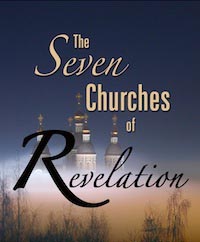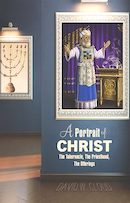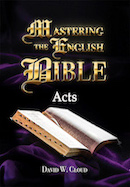866-295-4143, fbns@wayoflife.org

No one really likes to be on the receiving end of reproof, especially when the exhortation seems to be more of an unkind tongue lashing, but nothing is perfect in this world and we have to take the reproof as it is given rather than as we would like it to be given. This godly Bible-believing gentleman has every right to express his view, both privately and publicly. I have long said that public ministry can and should be critiqued publicly, and my course on Revelation (part of the Advanced Bible Studies Series) is a matter of public record. I have also said that no preacher is above godly reproof, and that certainly applies to me.
At the same time, being reproved does not mean that a man is wrong. Some people who write to correct me and then reprove me further for not agreeing with their reproof! They even charge me with pride because I don’t agree with their thinking. But I am under no obligation before God to agree with my reprovers. I am only under obligation to consider the reproof and to “prove all things” from God’s Word.
I have considered this man’s challenge, and I stand by my position. In fact, there is no doubt in my mind that it is a true one for the reasons I have given in my Advanced Bible Studies Series course on Revelation.
There is a four-fold application of Christ’s messages to the churches.
1. The messages were given to instruct the particular churches to which they are addressed.
2. The messages were given to instruct all churches. The instruction given to the seven churches of Asia in the first century applies to every church of every century (Rev. 2:7, 11, 17, 29; 3:6, 13, 22). Each church that has ever existed is similar to one of these seven.
3. The messages were given to instruct individual believers (Rev. 2:7, etc.). Every believer can find a wealth of edification and spiritual challenge and warning in these messages.
4. The messages offer a general overview of church history. This is not the main lesson of these chapters, and I believe that any approach that focuses exclusively or even largely on this aspect is wrong. This is the mistake made by Harry Ironside in his commentary on Revelation. My approach is entirely different. While I devote 5 pages of my commentary to the typical approach, I devote 84 pages to the practical application.
Yet it is possible to see a general outline of church history here by way of application and I do not believe this is an accident.
In fact, I believe that it is impossible not to see such an outline if we simply let the words of the text speak for themselves. Revelation 3:10 obviously looks beyond anything that was experienced by the historical church at Philadelphia in the first century. Let those who disagree with me explain when the historical church at Philadelphia was kept from the hour of temptation that shall come upon all the world? This clearly refers to the hour of the Tribulation described in Revelation 6-18, and the historical church at Philadelphia did not live to see that day. This is a promise that has encouraged every Bible-believing church of every century, and it was given to do so, but in ultimate reality it looks down the long corridor of time to the faithful Bible-believing congregations of the last hours of the church age, congregations that are struggling in the midst of terrible apostasy and compromise, congregations that live in the perilous times described in 2 Timothy 3. It is a promise that Jesus will be with them through the darkest part of the night and will then appear as the morning star to take them unto Himself in the glorious Rapture of the saints before the horrible Tribulation comes upon all the world.
By the divinely-inspired order of the messages to the seven churches, we see the same pattern of increasing apostasy that is revealed in other ways in the New Testament. Compare 2 Timothy 3:1-5, 13; 4:3-4. In 2 Timothy 3:13 the course of the church age is described in terms of increasing apostasy: “But evil men and seducers shall wax worse and worse, deceiving, and being deceived.” I believe we are living today both in the Philadelphian and the Laodicean age. These ages overlap. Though we are surrounded by the most incredible apostasy, there are still many Bible-believing churches that hold to the old paths and are patiently serving the Lord while waiting to be saved out of the world before the Tribulation begins.
As with a parable, it is wrong to try to press every detail mentioned in these messages toward a historical overview, but the major features do lend themselves toward such an overview in a surprisingly clear manner. Theodore Epp said: “If I were to give a title to this section I would call it ‘The Great Apostasy of the Last Days Traced from the Beginning of the Church’s History.’ We will see how Satan uses what I call ‘the whittling method’ of cutting away the essential features that make a church a church and finally makes it an arm of apostasy. Apostasy is defection from truth, revolt against it, and abandonment of what one has voluntarily professed, or a total departure or desertion from one’s faith or renunciation of it. This is a very serious matter; it began early in church history and will be consummated in the world after the true Church is gone. This decline in faith can be traced through these seven churches with the climax in the great apostate church of Revelation 17” (Epp, Revelation).
THE SEVEN CHURCHES OF REVELATION VIEWED PROPHETICALLY
EPHESUS (Rev. 2:1-7) -- The apostolic churches leaving their first love. The early churches as a whole gradually began to abandon their wholehearted zeal for Christ and His Word; they gradually ceased living by faith and settled down comfortably in the world rather than walking as pilgrims in a strange land. “Ephesus means ‘desirable,’ such a term as a Greek applied to the maiden of his choice. Ephesus gives us a picture of the church as it was in the beginning, when the Lord held the stars (His servants) in His hand and controlled their ministry. He sent them here and there, just as He would, to proclaim the glad gospel of His grace and to minister to His saints. ... The early church was walking in separation from the world. ... In the days of Ephesus, believers could not bear those who were evil. ... More than that, they were loyal to the truth” (Ironside).
SMYRNA (Rev. 2:8-11) -- Persecution and poverty and the synagogue of Satan. For more than 200 years the churches were persecuted by the Roman emperors. Christ mentions 10 days of persecution, and there were 10 major periods of persecution under 10 principal pagan persecutors (Nero, Domitian, Trajan, Marcus Aurelius, Severus, Maximum, Decius, Valerian, Aurelian, and Diocletian). There was also much poverty, because during this period the believers often had to live hand-to-mouth because many jobs were closed to them and they had to hide during the persecution. Judaism was also rampant throughout the Roman Empire and the Jews continued to hate the Christians and to torment them as they did during Paul’s day. It is written in church history that the Jews provided the wood to burn Polycarp in Smyrna. “Smyrna means ‘myrrh.’ Myrrh had to be crushed for it to emit its fragrance. This description sets forth the period when the church was crushed beneath the iron heel of pagan Rome, yet it never gave out such sweet fragrance to God as in those two centuries of almost constant martyrdom” (Ironside).
PERGAMOS (Rev. 2:12-17) -- Nicolaitanism was developed into a doctrine and Balaamism was rampant. “Nicolaitan” means “to conquer the people” and refers to the rise of the unbiblical hierarchical doctrine of church government. By the days of Constantine in the fourth century the bishop of Rome was exalted, together with his cohorts, and Nicolaitanism was well on its way to producing the papacy. In the early seventh century Gregory the Great solidified the papacy, becoming “the first of the proper popes” (Schaff, History of the Christian Church, I. 15), and later that century Pope Theodore I was the first pope officially called sovereign or supreme Pontiff (General History of the Church, Darras, II, p. 232). At the same time, there was a gross breakdown of separation from the world (the doctrine of Balaam), and unregenerate pagans were brought into church membership and their pagan practices, such as prayers to the dead and veneration of relics, were Christianized and adopted into the churches. “Constantine’s patronage did what Diocletian’s persecution could not do: it corrupted the church, and she forgot her calling as a chaste virgin espoused to an absent Lord. Then she gave her hand in marriage to the world that had crucified Him, thus entering into an unholy alliance of which she has never really repented” (Ironside).
THYATIRA (Rev. 2:18-29) -- The Jezebel spirit; idolatry, fornication, and involvement in satanic things. Jezebel brought fornication and idolatry into the churches and was associated with “the depths of Satan” (Rev. 2:20, 24). These practices, which began in earlier periods, became settled doctrine as the first millennium proceeded and the second began. Fornication became rampant in the Roman Catholic Church because of its unscriptural doctrine of celibacy and confession to a priest. The fornication surrounding the papacy itself has been well documented. Idolatry became rife, and Mary was exalted as the chief idol. “Whoredom, witchcraft, religious fasts,--and murdering God’s prophets,--this was Jezebel. Is not this also Rome? Jezebel also supported a horde of idolatrous priests of her own--Babylonians all” (Newell). “During this period also there began that exaltation of Mary the mother of our Lord which has tended to exalt her to the plane of a female deity through whom intercession to God should be made, and apart from whose favor there can be no salvation. The prominence of a woman prophetess in the church at Thyatira anticipates the prominence of this unscriptural exaltation of Mary” (Walvoord). “Jezebel was adept in the art of mixing. She undertook to unite the religion of Israel and the religion of Phoenicia. That is just what Romanism is--a mixture of heathenism, Christianity, and Judaism. It is not Christianity--yet there is in it quite a bit that is Christian. From where did its superstition and image worship come? It was all taken from heathenism under the plea that it would help to convert the pagans. The church became very accommodating. In the fourth, fifth, and sixth centuries, we find the church compromising with heathen rites and heathen ceremonies to such a degree that, by the seventh century, one could hardly tell heathen from Christian temples. The amalgamation is such that it is almost impossible to separate the one from the other. ... When He addresses Himself to the church of Thyatira, Christ speaks solemnly as ‘the Son of God.’ Why does the Lord Jesus Christ emphasize the fact of His deity here? Because Rome everywhere has accustomed people to think of Him as the Son of Mary” (Ironside).
SARDIS (Rev. 3:1-6) -- A partial, insufficient reformation. This church had a name that it was alive, but it was actually dead (Rev 3:1). Its works were not perfect before Christ (Rev. 3:2). The church was told to remember the first works, referring to the New Testament pattern given by the apostles (Rev. 3:3). All of these things are characteristic of the denominations that arose out of the Protestant Reformation in the 16th to the 18th centuries. They left the Catholic Church and rejected some of Rome’s false beliefs and practices, but they did not return to the pure apostolic model. They held to infant baptism, a special priesthood, sacraments, liturgy, and other errors. They established state churches and brought the unsaved into church membership by the rite of infant baptism. Thus, though they had a name that they lived, they were largely dead. “Nothing could describe ‘Protestantism’ more accurately! As over against Romish night and ignorance, she has enlightenment and outward activity: the great ‘state churches,’ or ‘denominations,’ with creeds and histories, costly churches and cathedrals, universities and seminaries, ‘boards,’ bureaus of publication and propaganda, executors of organized activities, including home and foreign missions, even ‘lobby’ men to ‘influence legislation’ at court! You and I dare compare the Church with no other model than the Holy Spirit gave at Pentecost and in Paul’s day! And compared to that--it has a name, but is dead” (Newell). “Nothing can be much sadder than vast congregations of people who are baptized, banded together as Christians, ‘taking the sacrament’ of the Lord’s Supper, zealous for church and Christianity, and yet largely devoid of personal, saving faith in Christ--trusting in forms, ceremonies, and what some people have called ‘birthright membership’ rather than in new birth through the Word and the Spirit of God” (Ironside).
PHILADELPHIA (Rev. 3:7-13) -- The churches that keep God’s Word (Rev. 3:8) and escape the great tribulation (Rev. 3:10). This depicts the remnant of sound churches that remain true to God until the Rapture. From the fact that Jesus’ promise to the church at Philadelphia obviously looks beyond anything that was experienced in that church historically and can only apply directly to churches existing at the time of the Rapture (“I also will keep thee from the hour of temptation, which shall come upon all the world, to try them that dwell upon the earth,” Rev. 3:10), we see that there will be Philadelphia churches existing in the darkest hours at the end of the church age. Many people today have abandoned the church as an institution, but Jesus said, “I will build my church, and the gates of hell shall not prevail against it” (Mat. 16:18), and He promised that He would be with it “even unto the end of the world” (Mat. 28:20). Thus in spite of the widespread apostasy that exists in our day we can be encouraged that there are true Philadelphia churches in the world and we are responsible to continue to support Christ’s chosen institution until He comes. We agree with Arno Gaebelein when he said, “Philadelphia is not a defined church-period, but rather a description of a loyal remnant called out by the Spirit of God and bearing the final testimony to the whole counsel of God by word and deed.” And Harry Ironside makes the following observation: “Following the Reformation came a time when a cold, lifeless formalism seemed to settle over all Protestant Christendom ... But in the eighteenth and nineteenth centuries a great wave of blessing came over all of those lands where the Reformation had gone. God began to work afresh in mighty power. Marvelous awakenings occurred all over Northern Europe and the British Isles. A half century later, the same mighty power began to manifest itself in America. ... A little later, in the early part of the last century, God began in a very special way to arouse many of His people to a deeper sense of the value of His Word and its all-sufficiency for the guidance of His people in this scene” (Ironside).
LAODICEA (Rev. 3:14-22) -- The unregenerate end-time church. This church is described as physically wealthy but spiritually wretched, and miserable, and poor, and blind, and naked (Rev. 3:17). The Lord Jesus is standing outside of this church inviting individuals to come to Him. This is a picture of the apostate churches of the last hours of the church age. Compare Revelation 18:4. “Laodicea is a compound word meaning ‘the rights of the people.’ Could any other term more aptly set forth the condition of modern affairs? It is the era of democratization in both the world and the church. ... The spirit of this ultra democratic age has invaded a large portion of the professed church. The authority of God and His Word is rapidly being denied. The spirit of the age is the spirit of a large part of the church; hence, the striking correspondence between this letter to the Laodiceans and the latitudinarianism so prevalent about us. ... There is neither burning zeal for His Word nor yet absolute repudiation of Christ and the Bible. Instead, there is a nauseating, lukewarm condition that is abhorrent to the Spirit of God. ... Never were church dignitaries and carnally minded religious leaders more satisfied with themselves and their great work than today. They advocate anything and everything that will seem to increase the church’s popularity. ... Ah, beloved friends, it is getting late in the dispensation, the night-shades are fast falling, and the Lord who, in the beginning, was in the midst of His church, stands outside that lukewarm system that calls itself by His name, and He knocks in vain for entrance!” (Ironside). “It is Laodicean,--conformed in everything to the popular judgment and will,--the extreme opposite of Nicolaitan. Instead of a Church of domineering clericals, it is the Church of the domineering mob, in which nothing may be safely preached except what the people are pleased to hear,--in which the teachings of the pulpit are fashioned to the tastes of the pew, and the feelings of the individual override the enactments of legitimate authority. It is lukewarm,--nothing decided,--partly hot and partly cold,--divided between Christ and the world,--not willing to give up pretension and claim to the heavenly, and yet clinging close to the earthly,--having too much conscience to cast off the name of Christ, and too much love for the world to take a firm and honest stand entirely on His side. There is much religiousness, but little religion; much sentiment, but very little of life to correspond; much profession, but very little faith; a joining of the ball-room to the communion-table, of the opera with the worship of God, and of the feasting and riot of the world with pretended charity and Christian benevolence. And it is self-satisfied, boastful, and empty. Having come down to the world’s tastes, and gained the world’s praise and patronage, the Laodiceans think they are rich, and increased with goods, and have need in nothing. Such splendid churches, and influential and intelligent congregations, and learned, agreeable preachers! Such admirable worship and music! Such excellently manned and endowed institutions! So many missionaries in the field! So much given for magnificent charities! Such an array in all the attributes of greatness and power! What more can be wanted? ... Can any man scrutinize narrowly the professed Church of our day, and say that we have not reached the Laodicean age?” (J.A. Seiss, The Apocalypse, 1900).
_______________

- Receive these reports by email
- www.wayoflife.org
______________________
Sharing Policy: Much of our material is available for free, such as the hundreds of articles at the Way of Life web site. Other items we sell to help fund our expensive literature and foreign church planting ministries. Way of Life's content falls into two categories: sharable and non-sharable. Things that we encourage you to share include the audio sermons, O Timothy magazine, FBIS articles, and the free eVideos and free eBooks. You are welcome to make copies of these at your own expense and share them with friends and family. You may also post parts of reports and/or entire reports to websites, blogs, etc as long as you give proper credit (citation). A link to the original report is very much appreciated as the reports are frequently updated and/or expanded. Things we do not want copied and distributed are "Store" items like the Fundamental Baptist Digital Library, print editions of our books, electronic editions of the books that we sell, the videos that we sell, etc. The items have taken years to produce at enormous expense in time and money, and we use the income from sales to help fund the ministry. We trust that your Christian honesty will preserve the integrity of this policy. "For the scripture saith, Thou shalt not muzzle the ox that treadeth out the corn. And, The labourer is worthy of his reward" (1 Timothy 5:18). Questions? support@wayoflife.org
Goal:Distributed by Way of Life Literature Inc., the Fundamental Baptist Information Service is an e-mail posting for Bible-believing Christians. Established in 1974, Way of Life Literature is a fundamental Baptist preaching and publishing ministry based in Bethel Baptist Church, London, Ontario, of which Wilbert Unger is the founding Pastor. Brother Cloud lives in South Asia where he has been a church planting missionary since 1979. Our primary goal with the FBIS is to provide material to assist preachers in the edification and protection of the churches.
Offering: Offerings are welcome if you care to make one. If you have been helped and/or blessed by our material offerings can be mailed or made online with with Visa, Mastercard, Discover, or Paypal. For information see: www.wayoflife.org/about/makeanoffering.html.





